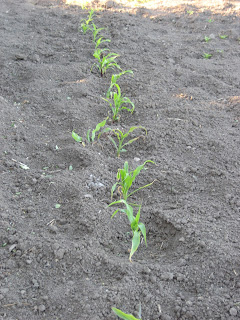Things are doing pretty good on the farm despite the very wet conditions. We are having to monitor disease caused by the rain and hot/humid air. So far it has not been too serious. The annual flowers are all starting to show blooms and the perennials are on track. The monkshood's are growing non stop and some of them are about six feet tall with the flower spikes. The lilies have started to bloom and I love to go out to the field and take in the kaleidoscope of colour. I have been enjoying watching the new annuals we planted, Cerinthe - Pride of Gibraltar, Icelandic Poppies, Celosia's of different shapes and colours, which are doing very well this year, Love Grass Ruby Silk (will post pictures later in the season), Drumstick flower, and Dianthus - neon purple and cherry. Watch for their debuts at the Farmers Market. Some cuts will be in bouquets this weekend. One of our Passion Flower Vines that is in the greenhouse has developed flower buds. This particular plant is destined for a new home this weekend.
The birds have been leaving their nests and a lot of species leave the yard when the babies are grown up. The Bluebirds have left, which in past years they raised a second brood. The Tree Swallows are gone, sometimes making an appearance in the evening. We now rely on the Dragonflies to help out with mosquito control, which they seem to be doing a great job. We have not had any bats take up residence in our bat houses we installed this Spring, and we have not seen any glimpses of them.
Today we will be busy harvesting vegetables, raspberries (first picking) and lots of fresh cut flowers.
Bells of Ireland
Karl Foerster Grass
Delphiniums
I came across this article written by the Saskatchewan Environmental Society and they asked that we share it with everyone. There is lots of really good information in the article.
Be Pesticide Free-Pesticides and Human Health
Have you heard? Pesticides aren’t needed for a beautiful lawn!
What is a Pesticide?
A pesticide is a chemical or microbiological substance that is designed to kill pests. Pesticides are by definition are toxic because they poison the pest. Pesticides include insecticides, herbicides, fungicides and rodenticides. Common examples are RoundUp, Killex, Weed and Feed, and 2,4-D. Lawn pesticides do not prevent pest problems, they only try to control them once they are present.
Exposure
Pesticides are all around us. They can be found in our soil, air, food, and even mother’s breast milk. If a pesticide is being applied to a lawn, it can be detected 15 metres away. Anyone living in an urban area in Saskatchewan breathes air with measurable quantities of 15-19 herbicides in late spring. Pesticides are also found in water. Drinking water in six Saskatchewan communities was tested and found to be contaminated with an average of seven pesticides.
Human Health
The Canadian Centre for Occupational Health and Safety has identified acute health effects in humans including nausea, eye, skin, respiratory and throat irritation, muscle spasms, and even death. Repeated exposure to pesticides has been linked to neurological problems, brain and lung cancer, immune suppression (which creates environmental hypersensitivity), leukemia, Parkinson’s disease, kidney damage, non-Hodgkin’s lymphoma and reproductive disorders, including endocrine disruption, low sperm count, and sterility. Children are most at risk as they typically play in grass and dirt, and put toys and hands in their mouths, activities that significantly increase their exposure to pesticides.
How to Protect You and Your Family
·Do not use pesticides on your lawn and garden.
·Pesticides are toxic. Be aware when they are being sprayed in your neighborhood.
·Keep kids and their toys indoors when pesticides are being applied and afterward, clean exposed surfaces.
· Do not spray your pets (flea powder).
· Use pesticide-free insect repellent like citronella.
· Buy local organic food.
· Wash all produce with a mild detergent.
· Work with local school boards, daycares and sporting complexes to go pesticide-free.
· Avoid pressure-treated wood.
To learn more about alternatives to using pesticides, please visit:
http://www.environmentalsociety.ca/main/resources/publication/pesticide-publications/





















































